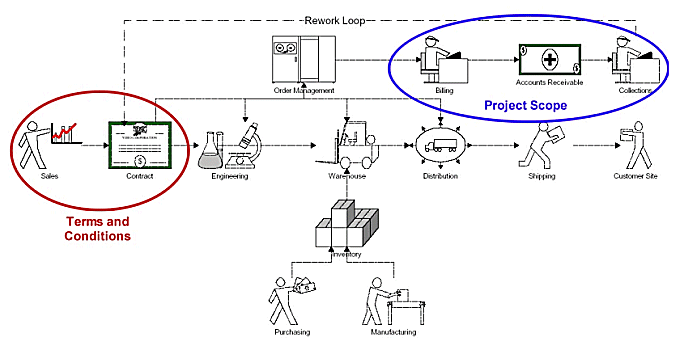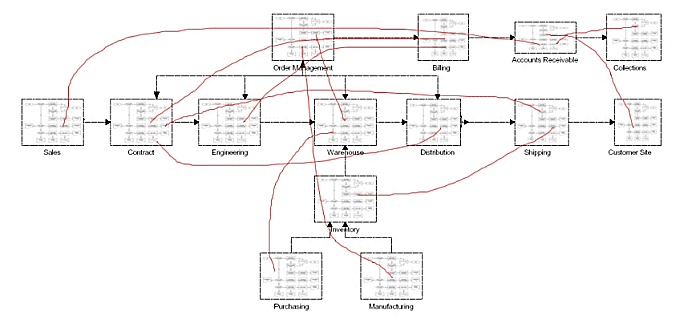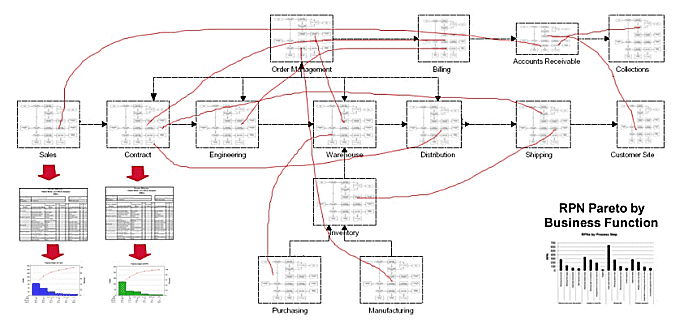
During the Define phase, it is common that a project is made smaller and more manageable by limiting the scope of the business process it will address. This may, however, cause problems during the Measure and Analyze phases when root causes outside the project scope are found.
An exploration of this issue is found in a case study that demonstrates how one company employed an integrated approach to bridge functional silos and achieves “customer impact” when the project scopes appeared mismatched to the resources available. By combining upper level process mapping with a series of failure modes and effects analyses (FMEAs), the company effectively scoped and managed an organization-wide initiative with hundreds of Six Sigma projects.
Finance Project That Went Out-of-Scope
An accounts receivable project was initiated in finance where only the latter end of the transaction with the customer was deemed as in-scope for the team. As the team brainstormed the causes of late payments, it found one of the largest causes of “late” payments was from mismatches in terms and conditions of service contracts. In short, the customers were not paying on time because there was a difference between the terms and conditions and what was delivered. Unfortunately, given the authority of the team, this root cause was deemed out-of-scope.
The project would have been too large if it were expanded to include the entire transaction, but the limited scope given to the original project would have resulted in an ineffective solution. Figure 1 shows one of many rework loops.

The finance Master Black Belt on the project came to the quality leader with what was beginning to become a trend in the company – solving problems by throwing them over the wall to another part of the company, or executing sub-optimal solutions within business functions. The problem with the Six Sigma implementation at this business was one of trying to assign process ownership to systemic problems, when the project Champions, sponsors, Master Black Belts, Black Belts and projects were all being managed at a business function level. Since projects were managed at the business function level, it was extremely difficult to assign ownership to projects that crossed the functional boundaries, hence solutions tended to be sub-optimal.
The quality leader for the entire business initiated a program with the purpose of making an impact on the customer while identifying and managing hundreds of individual projects within the business. The quality leader led “customer impact” projects using Six Sigma specifically for the purpose of defining roles and responsibilities and managing critical-to-quality (CTQ) elements. The CEO was the project sponsor and Champion. The operational definition of a defect for “customer impact” was: “Anytime the customer does not receive what we agreed to, when we agreed to supply it to them.” This project was not considered closed until all of the associated Six Sigma projects that impacted the problem had been identified, defined, executed and closed.
Defining and Mapping ‘Customer Impact’
The quality leader set out to map the entire quote-to-remittance process in detail across all the functional groups of the company. Since the company had more than 5,000 employees at various worldwide locations the entire process had never been mapped in great detail – it was simply too big.
Since the process was so big, it had to be broken into manageable pieces while preserving the integrity of the overall transactional flow. Process mapping for each functional group within the company was assigned to the respective Master Black Belt for that business function. The Master Black Belts coordinated the process mapping within their business functions. The quality leader provided specific guidance to ensure that the process mapping was done consistently across the functional areas, according to a common set of conventions for symbols, and to an appropriate level of detail. A clear definition of the handoff points between functional areas was particularly important.
When the functional process mapping was complete, each Master Black Belt brought their process maps to a “customer impact” war room to assemble them into a master process map of the entire transaction. The process maps were spaced out and taped to the whiteboard walls of the room. Even though this map contained only a moderate amount of detail, it had more than 500 steps and covered three walls of the room.
The next step was to define the rework loops between the functional groups. The subsequent data collection for this phase of “customer impact” was mostly centered on gathering data about rework and cross-functional problems. Cross-functional rework loops were added to the components of the master process map using dry erase markers. These cross-functional rework loops (Figure 2) were used to define the details of a communication plan. As well as to assign Champion ownership to specific project teams so that problems could be investigated and corrected.

Process FMEA for ‘Customer Impact’
Even though the company had defined the overall process, it still lacked a clear representation of the relative size of each contribution to the overall problem. The Master Black Belts were then asked to go back to their “customer impact” teams to first construct a more detailed process map to be used for diagnosis, then initiate a detailed FMEA of their section of the overall process map, conduct interviews with process owners and review any available historical data. Once again, the quality leader was active in defining common scales of measurement and scope of impact. The severity rating used in the FMEAs was addressed in terms of the impact on the customer of the sub-process – in other words, the next functional unit in the master process map. The addition of the cross-functional rework loops allowed the teams to evaluate the impact of defects outside their process areas without having to expand the scope of projects to include the entire process. These evaluations were conducted as defined in the new communication plan. Figure 3 shows the completed FMEAs and risk priority number (RPN) Pareto charts for the first two functional areas, sales and contract preparation.
When all FMEAs were completed for each of the functional areas, they were combined into one master FMEA and Pareto chart. The quality leader preferred the master Pareto chart to divide the ownership of problems between functional areas. This allowed him to see the vital Xs of a very large and complex process from a single, common viewpoint.

Six Sigma Project Management
The quality leader used the master process map, master FMEA and master Pareto chart to coordinate the entire set of projects needed to achieve the desired “customer impact.” He defined defect reduction themes within each functional area that would have an effect at the transactional level.
The Master Black Belts took the relevant defect reduction targets, and copies of the master process map and master FMEA back to their functional areas. There they defined projects, assigned project sponsors and Black Belts, executed and closed out projects and reported their progress back to the quality leader. The individual defect reduction themes within functional areas of the business were thus aligned with customer satisfaction at the upper level. The master process map allowed tightly scoped projects to be defined within functional areas while preventing sub-optimal solutions.
Conclusion: Insightful and Successful
This “customer impact” approach allowed the company to reverse sub-optimization and silo effects that had been the trend. By creating a big picture understanding of the entire transactional flow, teams were able to cross traditional functional boundaries and drive meaningful changes but achieving this view required strong oversight and management by the quality leader. Success was largely a function of managing and standardizing maps and risk assessments of the entire process. This overarching view of the entire flow, with all its key handoffs, gave insight into where the underlying issues impacting the efficiency and effectiveness of the process and who in the company is best equipped to correct these issues. The overall process was so successful that it is still in use for strategic planning within the company.